Day five was a sailing day. We lounged around the ship, reading, walking, and visiting.
It was a good day.
"Water, water, everywhere....."
Some people know how to take cute selfies
Some people know how to take scary selfies.
I could get used to this.
We may have eaten a few times on our sailing day.
Ok, we ate several times.
Alright, alright! We ate a lot!
Now that we are rested up from lounging and eating around the ship, we are prepared for a fantastic day in Barcelona. Barcelona was by far the best city we visited up to this point. We are going to do an on/off bus tour today, allowing us to get off when we wanted and spend as much time as needed at various points of interest.
This is the Military Government Building. This is going to be a city of lots of drive-by enjoying. There's so much to see.
Big cities love their monuments, fountains, and statues, and Barcelona had plenty of them. This is the Columbus Monument, built in 1888 for the World's Fair. It's intended to remind everyone that Columbus reported to Queen Isabella and King Ferdinand of Barcelona. It stands 197 feet tall.
The hanging anchor reminds the viewer of the importance of the sea in Mediterranean life.
The four winged angels fly to the four corners of the earth.
The large seated figures represent the four realms of Spain, and the standing figures around the base represent people important to Columbus.
This figure in particular strikes me as politically incorrect: a native American, grateful to have his culture, religion, and life disrupted by helpful Spanish interloper.
The 24 foot Columbus points to what some say is westward to the New World. Others think he points eastward toward his hometown of Genoa. In reality he points southwestward to the sea.
We sat in the windy top of a double decker bus to get the best views. That also allowed us to get pictures of interesting passing things with window bars in the middle of the picture, like Fountain of Caralan Genius, created in 1856. Sadly, we only passed it from the back.

Here's the front view from wikimedia.
This is Antonio Lopez y Lopez, He started a number of important companies in Spain.
Entitled Work, by Llucia Osle 1929. There's a similar statue somewhere in Barcelona entitled Wisdom with a woman holding the rearing horse.
Frederich Soler, famous poet, playwright, and supporter of the theater.
This sculpture of Illcineo I is a copy of a submarine and honors Narcis Monturiol, inventor of the first submarine powered by a motor.
And the most famous statue of all, American Tourists, by Anonymous.
As we traveled the city I snapped picture after picture from our double decker bus.Ignore the ghostly image of my seatmate Stan, also snapping picture after picture.
Barcelona is a beautiful, ancient city; dwellings and tombs date as far back as 5000 BC.
The next several pictures are our drive through town.
Glimpse of Barcelona cathedral.
The C & A Pelayo shopping center is a little fancier than our local Walmart.
Catalonia Square.
Barcelona has endlessly beautiful and ornate architecture. It would take months to properly explore this city.
A flock of pigeons and one tourist trying to...fly? get them to land on him? I read recently that Barcelona has been giving birth control to pigeons in an effort to control the explosive population. Maybe he's dispensing meds?
Now here's a great summer job! I hope she's making more than minimum wage.
I wish I knew what all of these fabulous buildings are.
The dome of an office building built in 1910, with angel and phoenix on top.
Nothing is boring here. Barcelona is a marvelous city.
This is a city of style, with soft colors allowing architecture to be the star.
I remember seeing rows and rows of bikes in Europe. Here the scooter is king.
We only had time to walk past the Gaudi house, known as Casa Batllo or Casa dels Ossos--House of Bones, so named because of its skeletal and organic properties.
Antoni Gaudi was a famous architect with a unique style called "Catalan Modernism".
Casa Batllo was an existing building, redesigned by Gaudi in 1904. The original building was built in 1877, and was described as "without remarkable characteristics". It was purchased by the Batllo family in 1900.
Josep Batllo hired Gaudi to create a home like no other, putting no restriction on Gaudi's creativity.
It was kept as a home until the 1950's. After it was sold 1954 it was used as offices, a museum, and as a rentable event facility.
I was disappointed that we didn't have time to go inside.
I'm putting it on my return visit bucket list, position number one.
When we told people we were headed to the Mediterranean, almost every single person told us to be sure to visit Sagrada Familia (Church of the Holy Family). After a visit, I totally understood why.
Sagrada Familia is also a Gaudi creation. The 1882 original designer was a man named Francisco Paula de Villa, but Gaudi got involved 1883 when Francisco resigned.
Gaudi transformed the original plan with his own Gothic and Art Nouveau style.
Gaudi spent the last years of his life working on his crowning creation, but after 43 years, it was only 25% done.
Progress has been slow due to the challenge of raising the necessary donated funds, the intricate and challenging design, and the Spanish Civil War. Completion reached the halfway point around 2010 and the current goal is to finish the project in 2026, 100 years after Gaudi's death.
Gaudi was a dapper young man, but as he aged he became increasingly religious and humble. He was a young man known for his stylish dress and impeccable grooming. He was an old man known for dressing simply, humble, even shabbily.
When he was 73 he was hit by a tram as he walked down the street to his own church to pray, knocking him unconscious. He was so humbly dressed no one recognized him and medical treatment was delayed. When he was finally recognized too much time had passed without appropriate treatment. He died two days later
Gaudi never married. The only woman he fell in love with did not return his feelings.
Gaudi was described as gruff and arrogant by those who didn't know. His friends say he was polite, pleasant and faithful.
His style is unlike anything I've ever seen.
It is beautiful, whimsical, elaborate, and alive. Here's a good example of Gaudi's design style: These colorful balls, still being worked on, are meant to represent harvest.
Although they are hundreds of feet above the ground, each ball is covered with small pieces of mosaic.
Parts of the unfinished basilica and plans and models were destroyed during the Spanish War of 1936. Plans had to be reconstructed.
Tourist entry fees are the source of the construction budget. Entrance is around $20, which raises $28.4 million a year. That's a lot of tourists visiting an unfinished church.
In many places you can see the newer sections vs the older, like the right towers compared to the weathered and stained older sections.
Is there a square inch on this building that is not interesting and appealing? I think not.
The stated purpose of Sagrada Familia is to honor the Family of Nazareth as a model for a united family.
Sagrada Familia also strives to provide keys of understand Christianity for all faiths or lack of faith and strives to promote Christian values of love, goodness, and peace.
Sagrada Familia can hold 200 people, and is 300 feet long, 200 feet wide, 560 feet tall.
Another good example of new construction (right) next to old (left).
Sagrada Familia is intended to remind visitors of God-given life, like these leaves
Next to the Holy Family
and alive with lizards and
bugs.
One of two turtles representing land and sea as well as time, which is set in stone and unchangeable.
The building is covered with three facades. The Nativity facade, built during Gaudi's life, is the most elaborate.
The Nativity facade celebrates the birth of Christ.
Gaudi intented to paint the figures in this facade, but that never came to pass.
This facade is intended to be accessible and to set the tone for the rest of the basilica.
Gaudi knew he would not live to see completion of the Sagrada Familia, and hoped to set a pattern and standard for the work that would take place long after he was gone.
I adore all of these depictions of Christ's birth.
Love this tender father/son scene. It must be Joseph and Jesus.
Gaudi began the Nativity facade in 1892.
This facade intermingles with religious motifs like the all-seeing eye and tree-like twisting form.
The Nativity facade faces east
Surprisingly, (at least to me) not everyone in Gaudi's day liked the basilica. Some thought it bizarre. The style is simply unlike anything people had seen. It lacked traditional style people considered respectful. Others called it a parody of other churches.
Gaudi used six different kinds of stone to create his masterpiece. He carefully planned and placed scenes to catch the right light or shadow.
Each face and figure is unique and alive. Look at the figures in the next several pictures: each is full of emotion.
The second facade is the Passion. Here, the figures are angular and stark, like this Judas kiss.
The Passion facade was started in 1954, long after Gaudi's death. It was made using Gaudi's drawings and instructions.
This facade was intended by Gaudi to strike fear into the hearts of the viewer.
It faces the setting sun, symbolic of Christ's death.
It's dramatically different from the happy, soft Nativity facade.
Note the solemn faces.
Even the setting is plain and sharp.
Stepping inside a cathedral or basilica is always an adventure. The outside might be beautiful, or plain, or ordinary. Will the inside match the outside or surpass it? The outside of Sagrada Familia is so stunning--can the inside match it?
Yes! Oh yes!
All of the stained glass windows have graduated glass, which Gaudi felt would create an atmosphere for introspection.
Windows mimic nature, with browns, golds, yellows at ground level, greens at flora level, and blues at sky level.
Stained glass is intended to draw the eye upward, to God.
The stained glass was carefully place to take advantage of the effects of the position of the sun throughout the day.
The pillars of this massive church are an architectural wonder. Gaudi designed them to look like trees, with leaning trunks, twisting branches, and unique characteristics.
Gaudi's intent was to create the feeling of a grove.
These pillars have been describe as "the canopy of heaven".
Windows were strategically placed to lessen the weight of the ceiling on the columns, while still taking advantage of sunlight and overall design.
The High Altar contains the "Calcification of Christ", a bronze by Carlos Mani
A nearby sign stated, "The stone towers Gaudi drew will rise into the sky and be the largest pre stressed stone constructions in the world.The final result will be an extraordinary work of art that changes depending on the point of view and time of day."
I've posted a number of pictures below to show the magnificence and variety of the interior.
Note how dark and shadowy this side of the basilica is. Of course, at the end of day this side will look completely different.
The Glory Doors, which tells the story of humanity and the paths to happiness.
From an explanation plaque: "The doors feature the text of the Our Father in Catalan (the Lord's prayer), surrounded by its central phrase in fifty different languages, as an expression of brotherhood between cultures."
More:
As we were leaving:
Next to the basilica is a school, built by Gaudi for the workmen's children.
Inside the school is a model of Sagarda Familia.
A picture in the school of Gaudi.
This was actually meant to be a temporary building, Neighborhood children could also attend.
It looks like a fun place to learn to read.
Our next stop was Park Guell, with this gingerbread house designed by Gaudi.
We stopped to buy cheap, but cute treasures for the kids back home.
More park structures designed by Gaudi.
A bubble maker in the park.
We climbed up the path to overlook the city.
We saw lots of this type of thing: a headless, chairless person, waving to people who walked by.
Gaudi is uber impressive and all, but here's the real masterpiece.
Our final stop of the day was Cathedral of the Holy Cross and Eulalia, of Barcelona Cathedral.
The cathedral was built from the 13th to the 15th century, mostly in the 14th. It is Gothic style. Like all ancient cathedrals, it was built over even more ancient crypts and chapels.
Although Sagrada Familia is the more famous building, Barcelona Cathedral is also interesting, with a unique history.
St Eulalia, the young girl the church was named for, was tortured to death in 303 because of her belief in Christ. She was 13.
Inside the cloister are 13 white geese, representing the 13 year old Eulalia. Ancestors of this flock have lived here since the cloister was built.
Because of the long construction period-more than 150 years-it is possible to see three different periods of construction.
The construction was slowed by the typical wars as well as several bouts of black death.
The cathedral was officially finished in 1448. That means it's 1390 years older than I am.
Yep, I'm a baby.
The main door.
Note the tiny figures framing the arch above the door.
Apostles adorn the exterior.
A "remember to be modest" sign.
Close up of the arch-framing figures.
I love this door.
One of two bell towers- the tallest point on the cathedral.
The church itself is 174 feet tall, measuring to the tallest tower. The ceiling is an impressive 92 feet tall.
This stained glass dates back to the 15th century.
Considering the large number of wars and natural disasters experienced over the centuries in this area, the fact that these windows have survived is remarkable.
Most of the windows date back to three periods: first period 1317-1334, second period 1400, and third period 1495.
Many of the windows are waaaay up.
I really like this one.
There's also some stained glass from the late 19th to early 20th century, like this one.
The Cathedral contains a number of crypts of VIPs, including Eulalia herself,
who is buried in the ancient crypt area under this part of the Cathedral.
I think these chandeliers are perfect for this Gothic style church.
Random details around the Cathedral.
Near by signs identify these sepulchers of the 1058 Count of Barcelona and his wife.
St. Oleguer, Bishop of Barcelona in 1116 and Archbishop of Tarragona from 1118-1137 (his death).
Side of St Oleguer's sepulcher.
We took an elevator to the top of the Cathedral.
I guess no one prefers the stairs here.
Yes, the sky really is this blue.
As we exited the Cathedral, we passed the 15th century Image of Christ de Lepant. Legend says Christ was present at the Battle of Lepanto and dodged a bullet in the heat of battle. This explains why Christ appears to be dodging to the right. Hmm.
What a perfect day! Time to enjoy the sunset and rest up for tomorrow.






















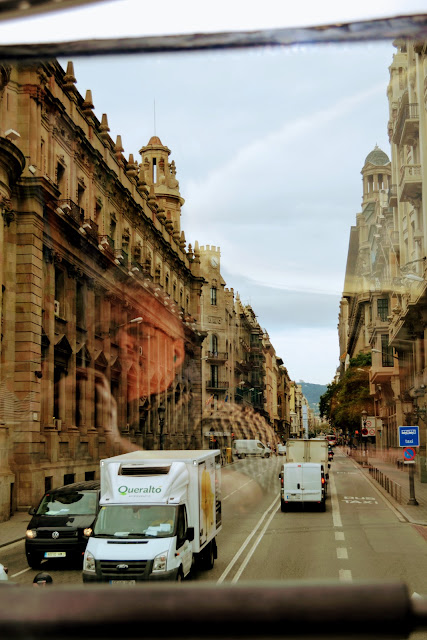





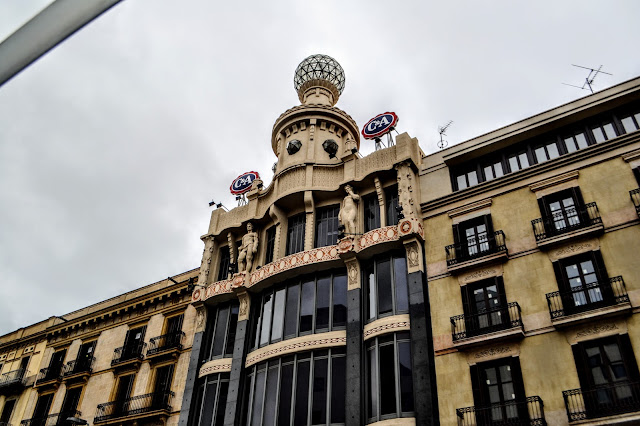





































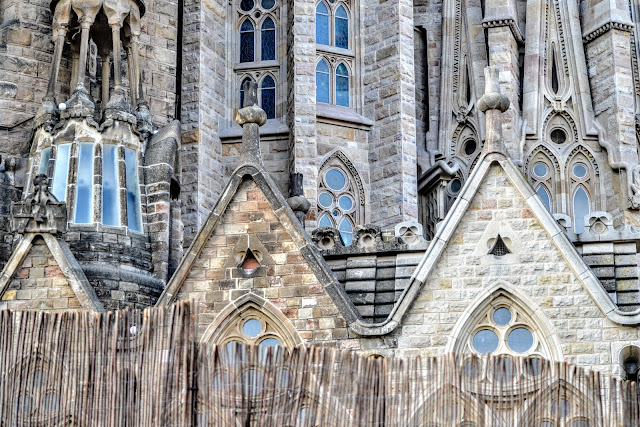




















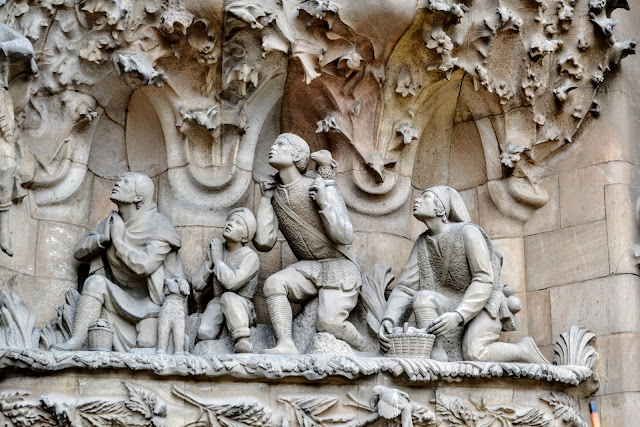




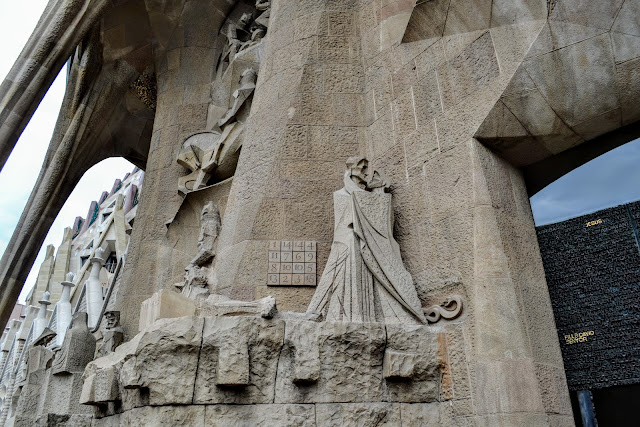






























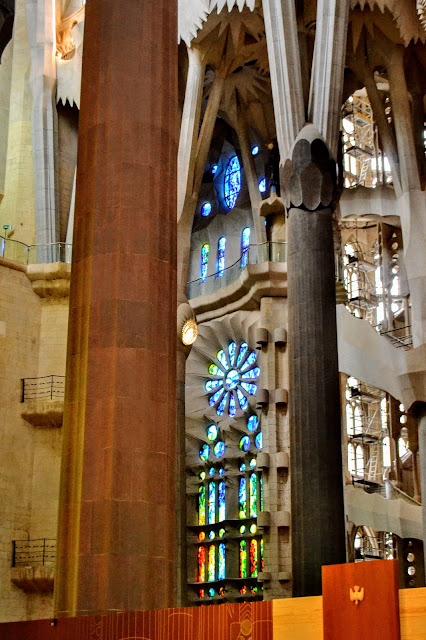



























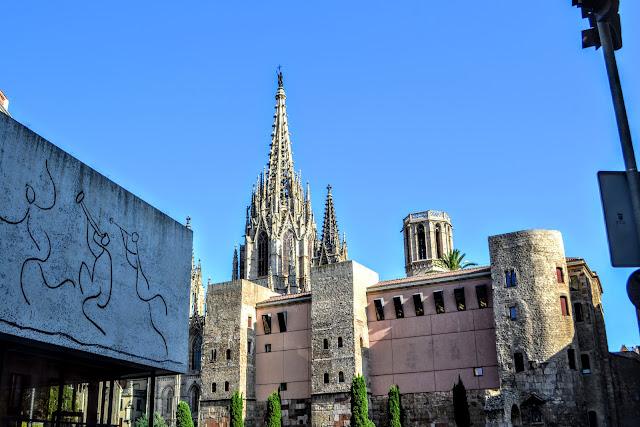








































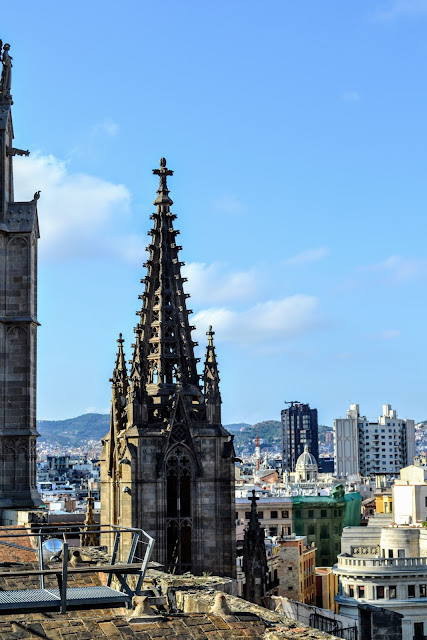





Barcelona is one of my favorite cities in the world. I love all things Gaudi. I love your photos of Sagrada Familia, especially those shots of the stained glass. When we were there in 2005, the interior was full of scaffolding. I think you got a much beter view than we did. I also love that last church, the Barcelona Cathedral. Barcelonians just have good artistic sense, don't they? Nice post.
ReplyDeleteYes, Barcelona is incredible. Looks like you really got around. In general, it looks like an amazing cruise. And the ship food looks really good too!
ReplyDelete